As the number of coronavirus cases continues to increase, and many states walk back prior reopening activity, liability attorneys are among those adapting to social distancing over an extended time period. While attorneys have done much to move claims forward during the pandemic, many claims remain stalled as attorneys often cannot, or choose not to, continue depositions under stay-at-home advisement.
However, our review of a Milliman database of defense attorney invoices1 suggests that, in general, delays in the deposition process are beginning to abate. Defense attorneys have gradually become comfortable with virtual depositions, and our analysis indicates they are soon likely to proceed with depositions over virtual platforms that are lengthier and more complex than the virtual depositions conducted to date.
In this article we follow up on previous research reviewing the Milliman database, which allows us to quantify both the shift forward of some claims at a quicker pace as well as the delay experienced by stalled claims. As the number of depositions remained down over 60% in May, those that occurred were typically associated with younger claims. However, the number of claims entering the deposition process was down 30% in April through June, suggesting that the shift toward younger claims will soon reach an endpoint.
We expect defense attorneys will shift their attention back to claims later in the deposition process. By the end of June, the number of depositions was down only 10% from previous averages, suggesting that most claims are now able to proceed through the deposition process. Like all of us, defense attorneys have adjusted to the "new normal."
Delays in claims reporting and closure
The Milliman database currently processes 16,000 open lawsuits monthly. In most months, 600 to 700 lawsuits are opened while approximately the same number close. The report rate fell by 25% in April and remained at that level in May, followed by a slight uptick in June. Given a typical delay of one to two years between an adverse event and a resulting lawsuit, we don’t believe this lower frequency is the result of fewer such events during COVID-19.2 Rather, court closures, stay-at-home advisements, and other concerns have likely all contributed to this lower report rate.
In contrast to the report rate, the closure rate increased during March (from about 4.0% to 4.7%) then fell subsequently. Claims handlers appear to have had time during the second half of March to close claims that might have otherwise remained open somewhat longer. The higher closure rate in March might explain the lower closure rate in April, but it can’t explain the decrease in the closure rate to 3.0% in May and June. Delays in trials, depositions, and other areas of the claims process have prevented claims from proceeding and reduced the overall closure rate.
Figure 1: Report and closure rates by month
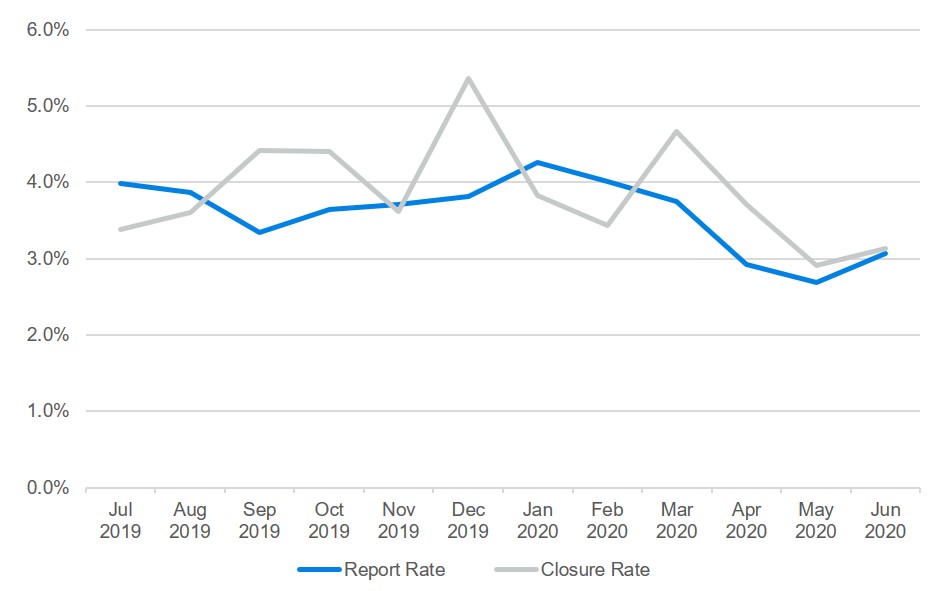
Depositions and claim age
The delay in claims handling is particularly apparent with depositions. The number of depositions dropped significantly in mid-March and remained low throughout April and May. Per open claim, the number of depositions was down 77% in April when compared to pre-COVID levels. However, by the end of June, the number of weekly depositions was only 10% short of the typical pre-COVID amount. By this point, attorneys appear to have become almost fully comfortable with virtual depositions. TSG Reporting, a worldwide provider of court reporting, estimates that its reporting services provided for virtual depositions increased by more than 1500% between March and July.3 However, as we will see, we believe attorneys continue to proceed with depositions primarily for select deponents.
Figure 2: Depositions per 1,000 open claims
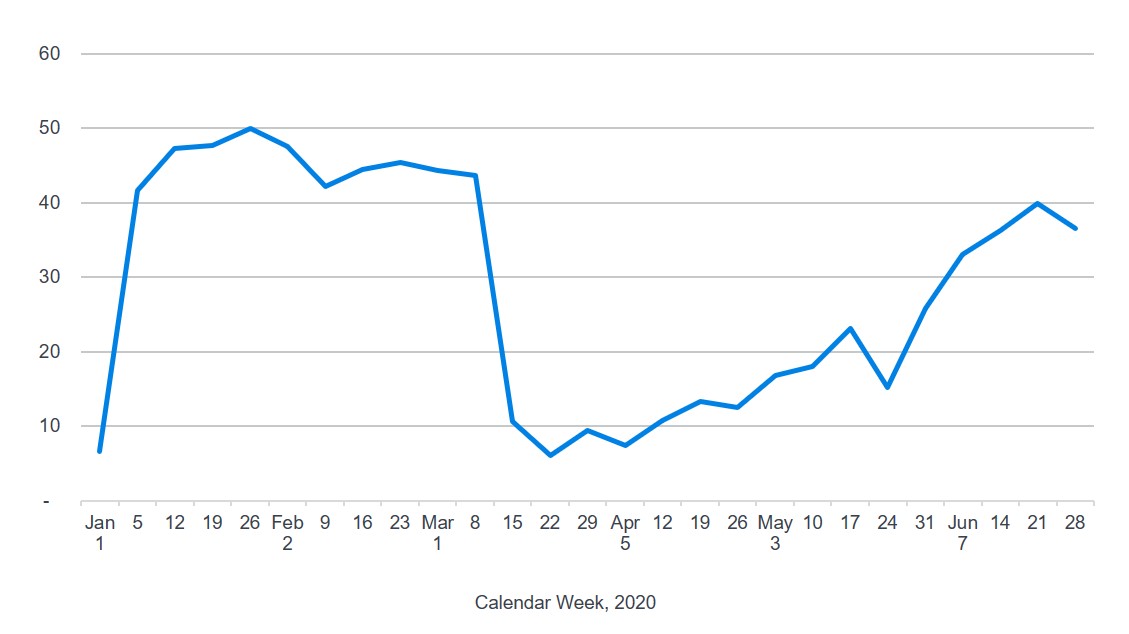
However, due to the build-up of delays in areas such as depositions, the average claim age has increased. For claims with deposition activity the average claim age, measured from the beginning of the deposition process,4 increased by three weeks during the period of stay-at-home advisement. This might sound like a small change, but considering that this increase was complete by the end of March, it suggests a noticeable and immediate lack of claims closure.
Figure 3: Average claim age measured from beginning of deposition process, in months
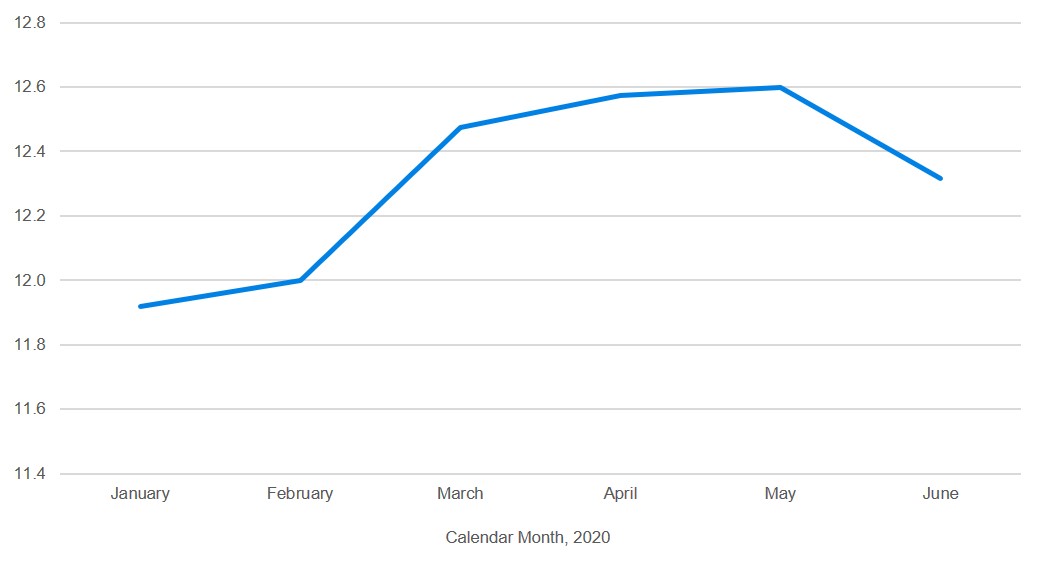
For about 10% of claims in the deposition process, deposition activity completely stalled through May. By “deposition activity” we are referring to depositions themselves as well as any related preparation or subsequent summarization of the depositions. This activity is identified by text mining the attorney invoices to identify which costs are deposition-related and the activity related to the deposition. For example, we would categorize “attend deposition of Dr. Smith” as “attend” and “sent letter to plaintiff attorney requesting to depose the plaintiff’s spouse” as “draft.”
For about half the 10% of claims in the deposition process showing no deposition activity through May, attorneys were able to resume deposition activity in June. Often a small number of expected depositions remain on these claims. Attorneys may have initially considered these depositions too lengthy or complex to conduct virtually. And especially if the deponent is a healthcare provider (as is the case with many of the liability claims in the database), it may be ill-advised to conduct the deposition in person at this time. But as virtual depositions became more normalized, we saw many of them begin to move forward this summer.
For most categories of deposition-related activity, average claim age (measured as above) has increased two to three weeks. However, the average claim age at the time of the deposition itself has fallen slightly during this same period.
Figure 4: Increase in average claim age for given deposition activity, in weeks
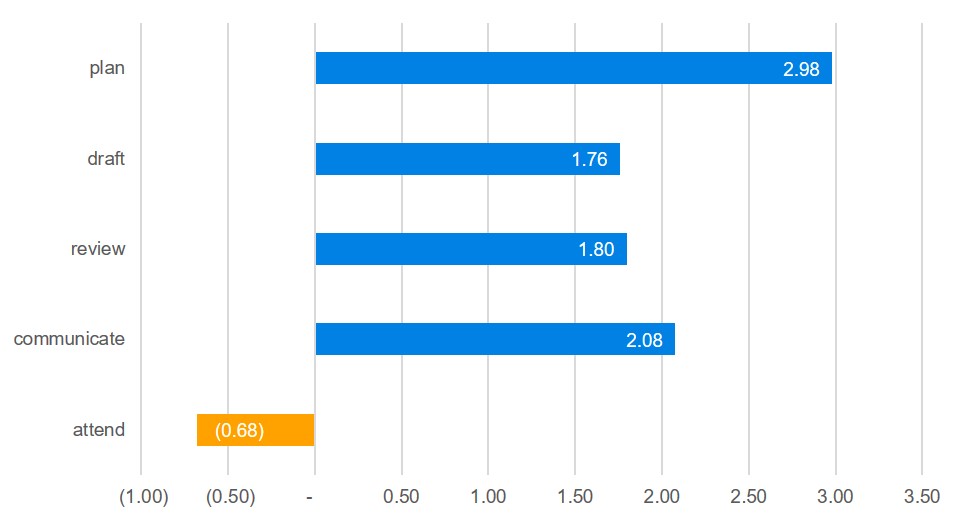
Hence communication and planning continue related to most claims. Yet these claims have aged as many of the remaining needed depositions (often expert witnesses) remain unscheduled. The depositions taking place currently are generally associated with claims having entered the deposition process more recently. Consistent with our prior research showing that depositions occurring under stay-at-home advisement are typically shorter,5 this seems to be a further indication that current depositions are generally less complex.
A shift in deposition timing
The overall decline in depositions has understated the true delay in the depositions process as it has not reflected the shift in depositions toward claims earlier in the deposition process. To see this shift in timing for the deposition process, consider the number of preceding deponents. On average, 5.7 deponents precede a given deposition (for an average of 12 to 13 total depositions per claim). This average fell to 5.2 preceding deponents in May, then 4.7 in June, as focus shifted toward earlier depositions.6 If we think of the deposition process as a timeline consisting of, on average, 12 to 13 deponents, then the typical currently scheduled deposition is now almost a full deponent earlier in this process.
Figure 5: Average number of preceding deponents per deposition
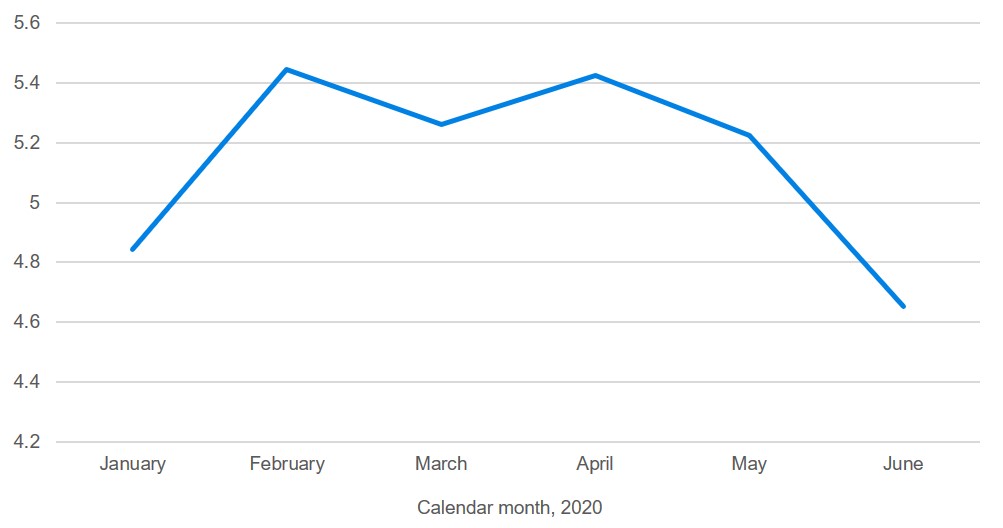
We can see how this shift occurs more clearly by looking at the change in the number of depositions along the deposition timeline. During April, while depositions declined overall, those occurring were 22% more likely to be the first deposition for the given claim. Claims where depositions had already taken place were more likely to be stalled.
In May and June, first through third depositions all increased proportionally relative to the February and March time period (becoming 15% more likely from 5%). Later depositions continued to be stalled.
Figure 6: Change in number of depositions by timing in deposition process
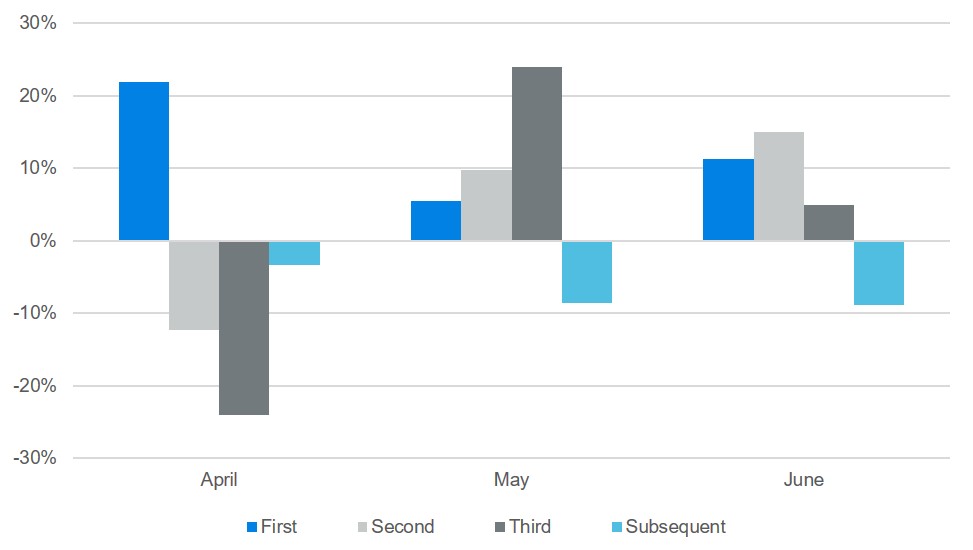
Much of this shift has resulted from deposing proportionally more plaintiffs and defendants, whose depositions occur earlier in the process. Hence their depositions are less reliant on prior discovery and easier to schedule earlier. At the same time, attorneys have deposed fewer fact witnesses and expert witnesses. Attorneys may be less inclined to depose expert witnesses over virtual platforms. While the depositions of fact witnesses are usually shorter and hence better suited for virtual platforms, they must usually follow the plaintiff and defendant in the timeline and hence cannot be scheduled earlier as readily.
Figure 7: Change in number of depositions by deponent, normalized for total deposition count
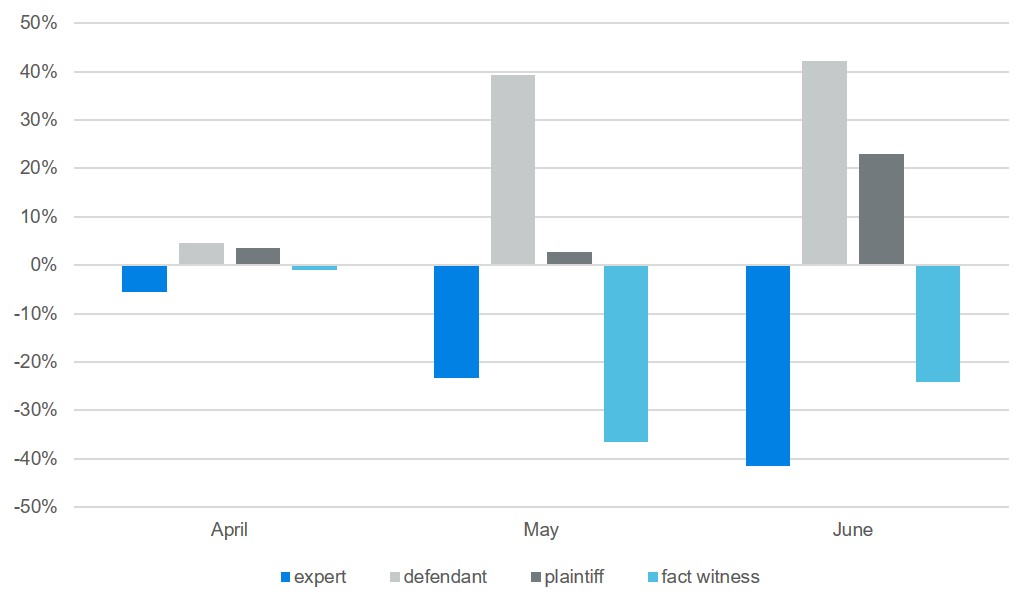
Depositions of plaintiffs and defendants are occurring about one month earlier. In contrast, expert witness depositions are occurring on claims two to four months older. It is rarely possible to move an expert witness’s deposition earlier in the calendar as the expert must first complete a report. Perhaps judges have insisted on moving along these depositions for certain older claims, resulting in this increase in claim age for expert witness deponents.7
Figure 8: Average claim age by deponent role, measured from beginning of deposition process, in months
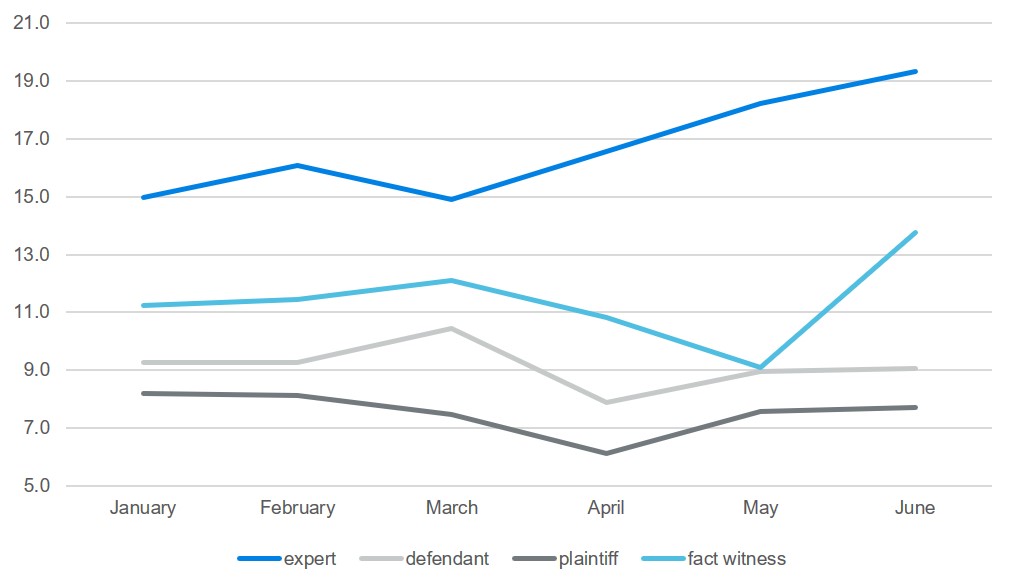
The average claim age for plaintiffs and defendants decreased in April but then increased to a more typical level in May and June. This suggests that those depositions conducted in April perhaps represented the youngest of the available claims. With only so many such claims available, the average age subsequently shifted back up. Indications such as these suggest both the flexibility of attorneys and others involved in the deposition process, but also that there are limits on how much such flexibility can change the typical timeline.
Future deposition activity
This shift toward depositions earlier in the process can only continue so long, especially given the recent lower rates of claims frequency. Either the number of depositions will fall after this shift reaches its endpoint, or attorneys will begin to move more complex depositions to virtual platforms.
One indication of future deposition activity can be measured by claims entering the deposition process. Using the same text mining process for the Milliman database described above, we observe that, for every 1,000 open claims, the number of claims entering the deposition process is typically about 13 per week. This fell to about nine per week in April and has remained at this level since that time, suggesting that attorneys have been reluctant to initiate depositions in the current environment. That reluctance may change as the availability of deponents for claims already in the deposition process continues to decline and as virtual depositions become more widely seen as the "new normal."
Figure 9: Claims entering deposition stage in 2020, per 1,000
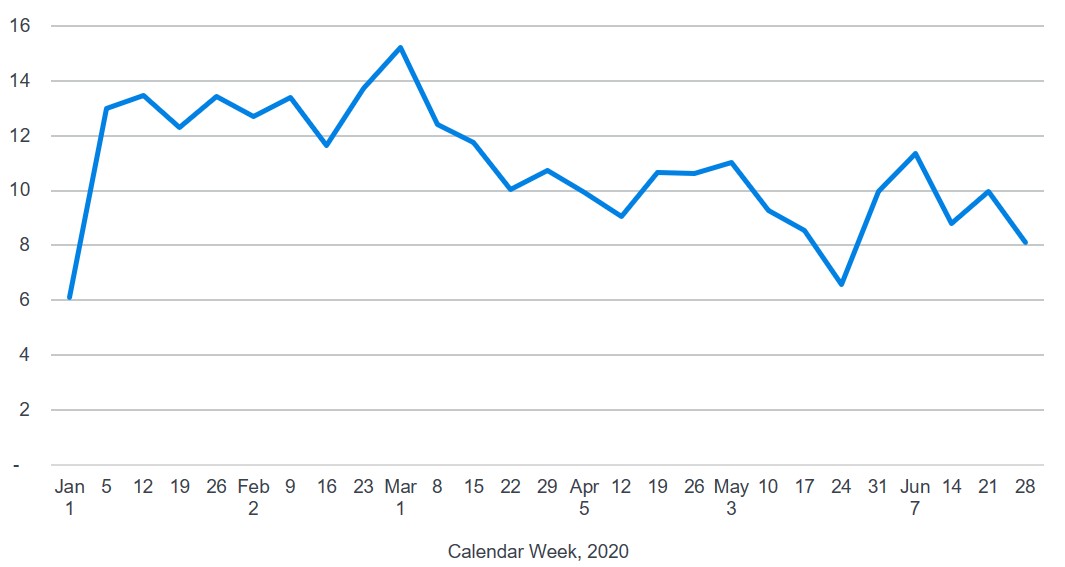
Defense attorneys have adapted well to the current environment in proceeding with those depositions best suited to virtual platforms. Faced with the possibility of a more widespread delay in deposition activity, insurers and attorneys are opting to conduct more complex depositions virtually. While virtual depositions are not without risk, the risk of a delayed claim may be greater. In addition, virtual depositions likely represent a cost reduction for insurers, both now and in the future. Insurers should continue to work with their defense attorneys to actively manage decisions on virtual depositions as delays in claims handling continue to abate.
1Database compiled and maintained by Milliman Datalytics Defense.
2Although fewer medical services have been provided under stay-at-home advisement, whether the shift in the nature of these services has led to fewer medical misadventures is unclear and may never be known.
3Personal correspondence with Joseph Gordon, Global Vice President of Sales for TSG Reporting.
4We consider the deposition process to begin at the first deposition activity for the claim itself or for any related claim on the same case.
5Forray, Susan, Karls, Chad, & Mawhinney, Joe. (June 22, 2020). Deposition delayed: Depositions decline due to COVID-19, but attorneys begin to grow comfortable deposing witnesses over virtual platforms. Milliman.com. Retrieved on August 7, 2020, from https://us.milliman.com/en/insight/deposition-delayed-depositions-decline-due-to-covid19-but-attorneys-begin-to-grow-comfortable
6The average for January is also low as this is a popular month for first depositions.
7The number of fact witness depositions is much smaller than these other deponents and hence their claim age is more volatile.